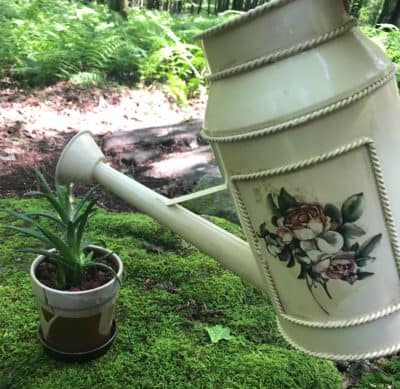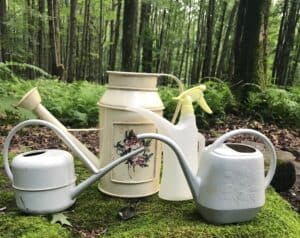This post contains affiliate links.
The beauty of indoor succulents lies in their diverse shapes and colors and incredible resilience. These charming, low-maintenance plants bring life to our homes and workplaces, capturing our hearts with their understated yet unique appeal. Yet, for all their ruggedness, one aspect needs careful consideration – watering. As easy as it might seem, watering indoor succulents can be tricky.
Indoor succulents typically require watering once every 1-2 weeks in the growing season (spring/summer) and once every 3-4 weeks during dormancy (fall/winter). However, always check the soil’s dryness before watering; it should be completely dry before the next watering.
Overwatering or underwatering can cause your plant to wither, lose its charm, or even die. This guide will enlighten you about the ins and outs of watering indoor succulents, aiming to transform you into a true succulent guru capable of fostering a collection of healthy, thriving plants.

Water Requirements of Indoor Succulents
Succulents are known for their water-storing capabilities, enabling them to thrive in arid environments. The word succulent means “full of juice, or juicy” and succulent plants are defined as plants with succulent tissues that store water, making them independent from an external water supply. (Reference)
This unique attribute directly impacts their water requirements when kept indoors. Here are some key points to consider about the water requirements of indoor succulents:
Soil Dryness: Succulents prefer their soil to dry out completely between watering sessions. This is why a well-draining soil mix, typically used for cacti and succulents, is highly recommended. It ensures that water doesn’t remain around the plant roots for too long, preventing root rot and other water-related diseases.
There are many commercial soils to choose from but I have had good results with Bonsai Jack Succulent and Cactus soil, found on Amazon.
I have also used Miracle-Gro Succulent potting mix, also from Amazon, with good results, but I amend it with perlite to add more aeration to the soil.
If you aren’t interested in buying commercial succulent soil, check out our helpful guide on how to make your own.
Watering Frequency: How often you water your succulents depends on many factors, including the type of succulent, the size of the pot, the type of soil, the humidity in your home, and the current season. Generally, a watering routine is advisable once every 1-2 weeks during the growing season (spring and summer) and once every 3-4 weeks during dormancy (fall and winter). However, this is not a strict rule and can be modified based on your specific conditions.
Amount of Water: Following the “soak and dry” method is better when watering succulents. This means you should water the plant thoroughly, allowing water to drain out of the bottom of the pot, and then let the soil dry out completely before watering again. Succulents prefer this deep, infrequent watering to frequent, shallow watering.
Type of Water: Most tap water is fine for succulents, but if tap water is heavily chlorinated or has a high mineral content (hard water), it might be better to use distilled or rainwater.
The key to succulent watering is balance. Too little water and the plant can become dehydrated and shriveled; too much water is at risk of root rot. Understanding your plant and adjusting your care based on its signals will help you maintain happy and healthy indoor succulents.

Signs of Overwatering and Underwatering Your Succulents
Detecting overwatering and underwatering is crucial for the health of your succulents. Each condition manifests through different symptoms, and understanding these can help you adjust your watering routine accordingly.
Signs of Overwatering
- Swollen or Discolored Leaves: An overwatered succulent often has soft, mushy leaves that may turn yellow or black. These are signs of root rot caused by excessive moisture.
- Wilting: Despite plenty of water, an overwatered succulent may appear wilted. This is due to damage to the roots, which can no longer efficiently deliver nutrients to the plant.
- Leaves Falling Off Easily: If your succulent leaves are falling off at the slightest touch, it may be receiving too much water.
- Root Rot: The most severe sign of overwatering, visible when you remove the plant from its pot. If the roots are brown and smell musty, it’s a clear sign of root rot.
Signs of Underwatering
- Shriveled Leaves: If your succulent is underwatered, its leaves will wrinkle or fade. Unlike overwatering, the leaves will feel dry and crispy rather than soft and mushy.
- Discoloration: Underwatered succulents may change color. Some turn purple or red as a form of sun stress, while others might lose their vibrant color and turn a dull green.
- Slowed Growth: Succulents not getting enough water will have stunted growth, and new leaves may be smaller than usual.
- Leaf Drop: Severe underwatering can lead to lower leaves drying up and falling off the plant. Unlike overwatered succulents, these leaves typically dry up completely before falling off.
Recognizing these signs will help you correct your watering habits before your plant’s condition worsens. Remember, it’s easier to revive an underwatered succulent than an overwatered one, so when in doubt, it’s better to err on the side of too little water.

The Perfect Watering Routine for Your Succulents
Creating the perfect watering routine for your succulents means understanding their needs and the environmental factors influencing them. While there’s no “one-size-fits-all” watering routine, here are some general steps to guide you:
- Check the Soil: Always check the dryness of the soil before watering. The soil should be completely dry before the next watering session. You can check how dry the soil is by sticking your finger or a toothpick into the soil. If it comes out dry, it’s time to water. Some people suggest using a skewer stick (such as the type used in shish kebabs) since it can reach further down in the soil than a toothpick, giving you a better idea of how dry the soil is.
Another way to check the soil is by using a soil moisture meter. Check out our article here on how to use one, and this article on how they work.
- Water Thoroughly: Follow the “soak and dry” method when watering. This means thoroughly drenching the soil until water drains out of the bottom of the pot. Avoid misting or lightly sprinkling water onto the surface.
- Wait for the Soil to Dry Completely: Allow the soil to dry completely before watering again. The time this takes can vary depending on soil type, pot size, pot material, and indoor humidity.
- Make Adjustments According to the Season: Watering should be more frequent during the growing season (spring and summer) and less frequent during the plant’s dormant period (fall and winter). On average, you should be watering your succulents every 1-2 weeks in the growing season and every 3-4 weeks in the dormant period.
- Consider Environmental Factors: If you live in a dry climate or if your indoor air is dry, your succulents may need watering more often. Note that In the wintertime, indoor humidity in Northern climates is generally very low. The opposite can be true for the summer months.
If you live in a humid environment, you might want to check out this dehumidifier on Amazon. It is a newer model of the one I use at my home and it helps out a lot during those humid, summer days.
- Similarly, if your succulents receive a lot of light, they may require more frequent watering.
Each succulent is unique and may have slightly different watering needs. Pay close attention to your plant’s health and adjust the watering routine. The key is to provide enough water for your succulents to thrive but not so much that it leads to overwatering and root rot.
Factors Influencing Watering Frequency
Several factors can influence how frequently you should water your indoor succulents. Understanding these can help you fine-tune your watering routine for optimal plant health.
1. Type of Succulent: Different succulent species have different water needs. Some succulents, such as sedums and graptopetalums, require more frequent watering than cacti or lithops.
2. Pot Size and Type: Small pots dry out faster than large ones, requiring more frequent watering. Also, the material of the pot matters. Clay or terracotta pots are porous and allow water to evaporate more quickly than plastic or glazed ceramic pots.
3. Type of Soil: Succulents need well-draining soil, usually a mix of potting soil and a material like perlite or sand, which helps prevent water from staying around the roots for too long. The faster your soil drains, the more frequently you need water.
4. Environment: Indoor environments can vary significantly in humidity and temperature, affecting watering frequency. A warm, dry environment will cause water to evaporate more quickly, meaning you may need to water more often. Conversely, in a cool or humid environment, water will evaporate more slowly, and you should water less frequently.
5. Light Exposure: Succulents need plenty of light, and those receiving more light typically need more water than those in shadier locations. However, direct sunlight can cause the water to evaporate too quickly, leading to underwatering.
6. Growth Stage and Season: Succulents typically need more water during their active growth stages in the spring and summer. In contrast, they require less frequent watering during their dormant periods in the fall and winter.
By keeping these factors in mind, you can tailor a watering routine to meet the specific needs of your indoor succulents, leading to healthier and happier plants.
Seasonal Considerations for Watering Indoor Succulents
Just as the seasons outside change, your indoor succulents also experience seasonal changes. These changes greatly influence the watering needs of your plants.
In the growing season, which is typically spring and summer for most succulents, the plants are actively growing. This is the time when they consume more water to support new growth. Therefore, you’ll need to water them more frequently, typically every 1-2 weeks, depending on the type of succulent and the environmental conditions. However, allow the soil to dry out completely between waterings to prevent overwatering.
On the other hand, during the fall and winter months, most succulents enter a dormant or resting phase. During this period, their growth slows down, and so do their water requirements. Reducing watering during this time is essential, extending the interval to around once every 3-4 weeks. Again, this frequency is a general guideline, and the best practice remains to check the soil’s dryness before each watering.
Remember, these seasonal considerations are a general rule. Some succulents, like Aeoniums, are winter growers and will have their watering needs reversed. Therefore, always research your plant’s specific needs and adjust your care accordingly.
Understanding these seasonal needs and adjusting your watering schedule to accommodate them is key to keeping your indoor succulents thriving all year round. Your attentive care, suited to each season, will help your succulents maintain their health and showcase their beauty no matter the time of year.
Tips and Tricks for Proper Succulent Watering
Nailing the right watering technique can make a significant difference in the health and vitality of your indoor succulents. Here are some practical tips and tricks to keep in mind:
- Water the Soil, Not the Leaves: Always aim to water the soil directly. Wet leaves, especially in low light, can encourage fungal growth and lead to rot.
- Use a Watering Can with a Narrow Spout: This allows you to direct the water to the soil without splashing the leaves.
- Follow the ‘Soak and Dry’ Method: Thoroughly drench the soil until water drains from the bottom of the pot. This ensures the roots get enough water. Wait until the soil is completely dry before the next watering.
- Stick to a Routine but Stay Flexible: While having a routine is good, you should adjust the watering frequency based on the plant’s needs and the changing environment.
- Use the Right Soil: A well-draining soil mix is essential for succulents. It allows water to drain quickly and prevents waterlogging.
- Avoid Watering on a Schedule: Instead of watering on a strict schedule, assess each plant’s needs by checking the soil moisture.
- Adapt to the Seasons: Water more frequently during the growing season (spring and summer) and less during the dormant period (fall and winter).
- Don’t Be Afraid to Adjust: If your plant shows signs of overwatering or underwatering, don’t be afraid to adjust your routine. It’s part of the learning process.
The goal of watering is not just to hydrate the plant but also to encourage deep root growth and overall health. With these tips in mind, you’ll be well-equipped to provide succulents with the care they need to thrive.
This post was written for cactus-central.com and is not permitted to be used on other sites.


